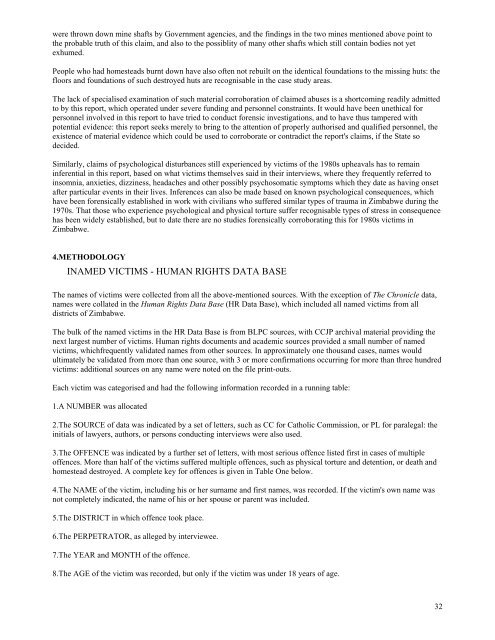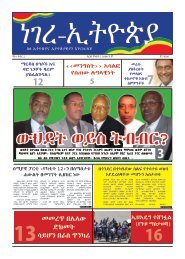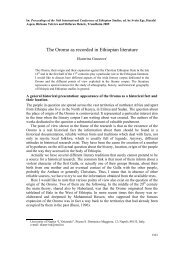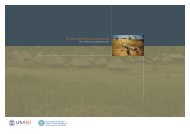MatabelelandReport
MatabelelandReport
MatabelelandReport
You also want an ePaper? Increase the reach of your titles
YUMPU automatically turns print PDFs into web optimized ePapers that Google loves.
were thrown down mine shafts by Government agencies, and the findings in the two mines mentioned above point to<br />
the probable truth of this claim, and also to the possiblity of many other shafts which still contain bodies not yet<br />
exhumed.<br />
People who had homesteads burnt down have also often not rebuilt on the identical foundations to the missing huts: the<br />
floors and foundations of such destroyed huts are recognisable in the case study areas.<br />
The lack of specialised examination of such material corroboration of claimed abuses is a shortcoming readily admitted<br />
to by this report, which operated under severe funding and personnel constraints. It would have been unethical for<br />
personnel involved in this report to have tried to conduct forensic investigations, and to have thus tampered with<br />
potential evidence: this report seeks merely to bring to the attention of properly authorised and qualified personnel, the<br />
existence of material evidence which could be used to corroborate or contradict the report's claims, if the State so<br />
decided.<br />
Similarly, claims of psychological disturbances still experienced by victims of the 1980s upheavals has to remain<br />
inferential in this report, based on what victims themselves said in their interviews, where they frequently referred to<br />
insomnia, anxieties, dizziness, headaches and other possibly psychosomatic symptoms which they date as having onset<br />
after particular events in their lives. Inferences can also be made based on known psychological consequences, which<br />
have been forensically established in work with civilians who suffered similar types of trauma in Zimbabwe during the<br />
1970s. That those who experience psychological and physical torture suffer recognisable types of stress in consequence<br />
has been widely established, but to date there are no studies forensically corroborating this for 1980s victims in<br />
Zimbabwe.<br />
4.METHODOLOGY<br />
INAMED VICTIMS - HUMAN RIGHTS DATA BASE<br />
The names of victims were collected from all the above-mentioned sources. With the exception of The Chronicle data,<br />
names were collated in the Human Rights Data Base (HR Data Base), which included all named victims from all<br />
districts of Zimbabwe.<br />
The bulk of the named victims in the HR Data Base is from BLPC sources, with CCJP archival material providing the<br />
next largest number of victims. Human rights documents and academic sources provided a small number of named<br />
victims, whichfrequently validated names from other sources. In approximately one thousand cases, names would<br />
ultimately be validated from more than one source, with 3 or more confirmations occurring for more than three hundred<br />
victims: additional sources on any name were noted on the file print-outs.<br />
Each victim was categorised and had the following information recorded in a running table:<br />
1.A NUMBER was allocated<br />
2.The SOURCE of data was indicated by a set of letters, such as CC for Catholic Commission, or PL for paralegal: the<br />
initials of lawyers, authors, or persons conducting interviews were also used.<br />
3.The OFFENCE was indicated by a further set of letters, with most serious offence listed first in cases of multiple<br />
offences. More than half of the victims suffered multiple offences, such as physical torture and detention, or death and<br />
homestead destroyed. A complete key for offences is given in Table One below.<br />
4.The NAME of the victim, including his or her surname and first names, was recorded. If the victim's own name was<br />
not completely indicated, the name of his or her spouse or parent was included.<br />
5.The DISTRICT in which offence took place.<br />
6.The PERPETRATOR, as alleged by interviewee.<br />
7.The YEAR and MONTH of the offence.<br />
8.The AGE of the victim was recorded, but only if the victim was under 18 years of age.<br />
32







